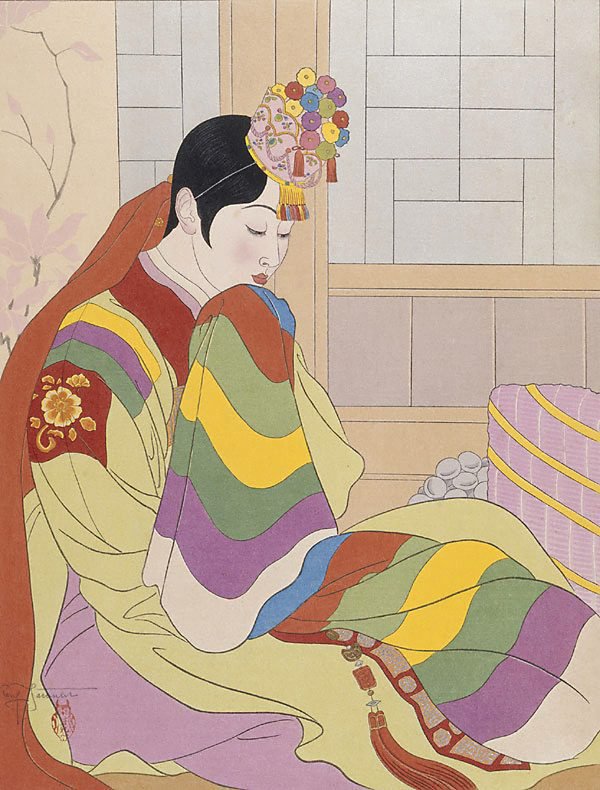-
Details
- Place where the work was made
-
Japan
- Period
- Shōwa period 1926 - 1988 → Japan
- Date
- 1948
- Media category
- Materials used
- colour woodcut
- Edition
- 38/250
- Dimensions
- 39.4 x 30.1 cm image; 47.0 x 36.2 cm sheet
- Signature & date
Signed l.l., pencil "Paul Jacoulet" [and artist's owl seal]. Not dated.
- Credit
- Gift of Kit McKenzie 1997
- Location
- Not on display
- Accession number
- 403.1997
- Copyright
- © Estate of Paul Jacoulet/ADAGP. Copyright Agency
- Artist information
-
Paul Jacoulet
Works in the collection
- Share
-
-
About
Paul Jacoulet holds a unique position in the world of international graphic art. Born as the only son of French parents, Jacoulet was taken to Japan in 1899 (the year of his birth is being disputed) as a small child, and remained in the country throughout the turbulent years of the Great Kanto Earthquake (1923), the depression (late 1920s) and the war (1937-45). He also travelled extensively, from his native France to Korea and the South Pacific islands under Japanese occupation.
After the Great Kanto Earthquake, Jacoulet began concentrating on painting with financial support from his mother in Korea. He painted initially in the style of the traditional Japanese ukiyo-e. In the 1930s, Jacoulet decided to turn his works into prints. At the time, there were two streams of printmaking in Japan: the Creative Print Movement (which insisted that the artist drew, blockcut and printed his own work) and the New Print Movement (the artist had his designs blockcut and printed by skilled professionals). Although he kept distance from the Japanese art circles, Jacoulet, a deep admirer of ukiyo-e prints, decided to take the approach adopted by the New Print artists. He initially employed Yamagishi Kazue, a skilled professional blockcutter and printer who is also a print artist in his own right (the Gallery has one of his works in the collection). Eventually Jacoulet and Yamagishi parted when the latter began to undermine the artist's control over the production of the print. He engaged other skilled professionals for his later prints.
Jacoulet's style is neither Western nor Japanese: it is hybrid. His subjects are 'exotic people' of Japan, Korea, China and the South Seas. While an 'Orientalist gaze' is apparent in the treatment of his subjects of what Richard Miles calls 'disappearing people', one can observe his strong sympathy with them. Furthermore, his 'Orientalism' is not a sentiment unique to the West, either: it can be comfortably placed in the modern Japanese context. Some Japanese painters contemporary to Jacoulet, notably Kawabata Ryûshi, share the same 'gaze' in the treatment of the islanders.
This print of a Korean bride was not made as a pair to Jacoulet's print of a groom ('Le marie Seoul, Corée 1950') - also in the gallery's collection - although they deal with the same subject. These prints reveal the artist's psychological insight into a shy bride & a rather tense groom, both in traditional costumes richly coloured & printed.
-
Places
Where the work was made
Japan
-
Exhibition history
Shown in 1 exhibition
Correspondence, Art Gallery of New South Wales, Sydney, 10 Sep 2022–2024
-
Bibliography
Referenced in 2 publications
-
Ann Macarthur, Look, 'Did fashion begin in Asia?', pg. 47, Sydney, Dec 2008-Jan 2009, 47 (colour illus.).
-
Kiyoko Sawatari (Curator) and Yokohama Museum of Art (Editor), Eyes toward Asia: Ukiyoe artists from abroad, Tokyo, 1996, 211 (colour illus.), 152.
-
-
Provenance
Kit McKenzie, Oct 1997, New South Wales/Australia, donated to the Art Gallery of New South Wales, Sydney, Oct 1997.


